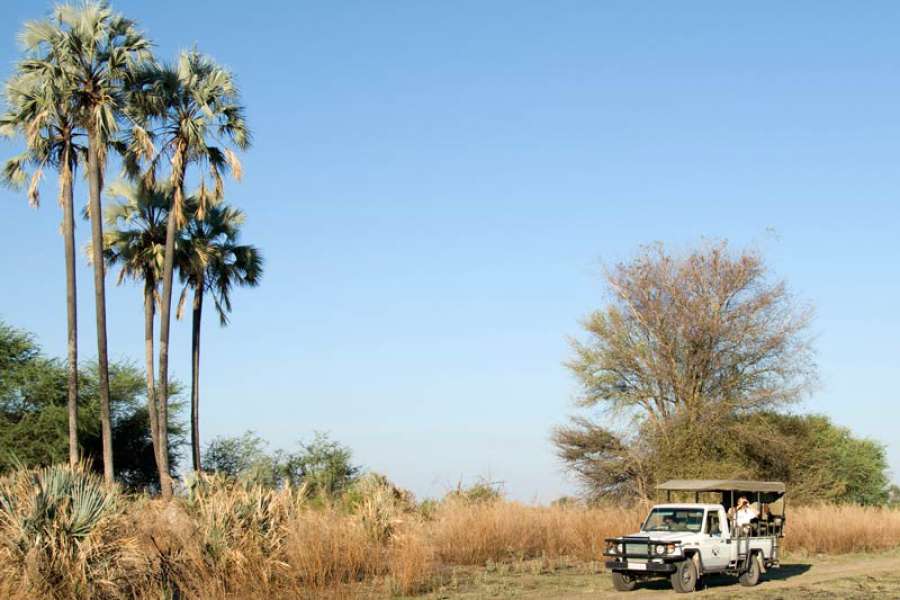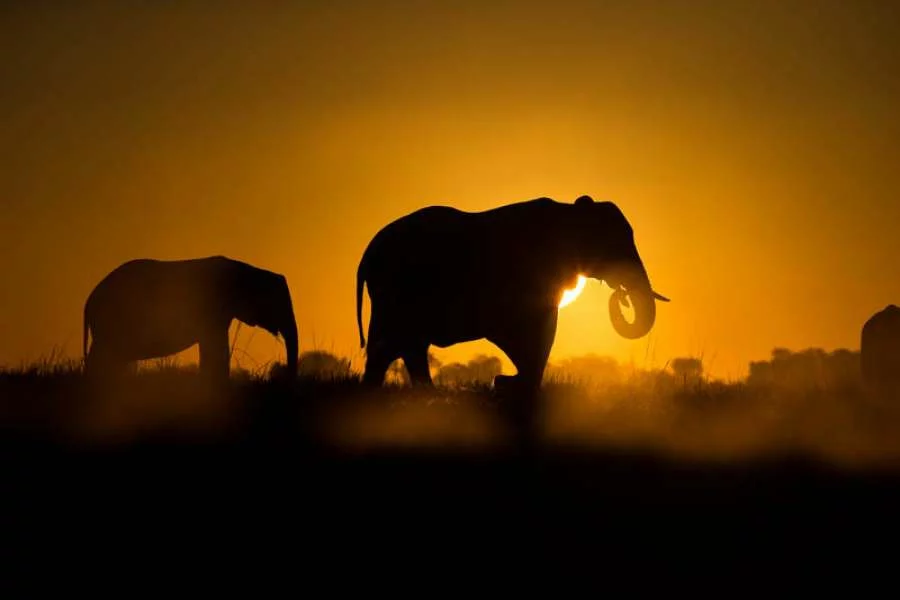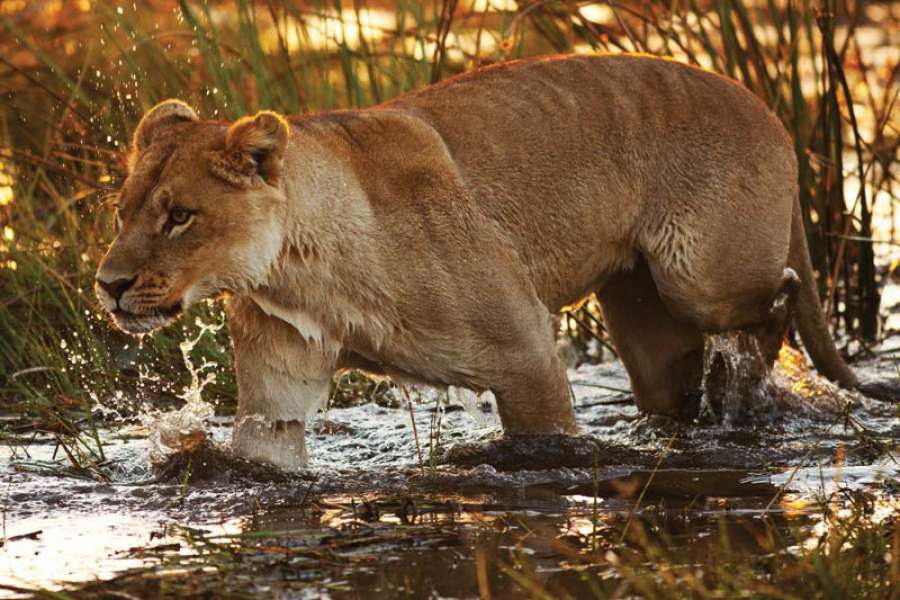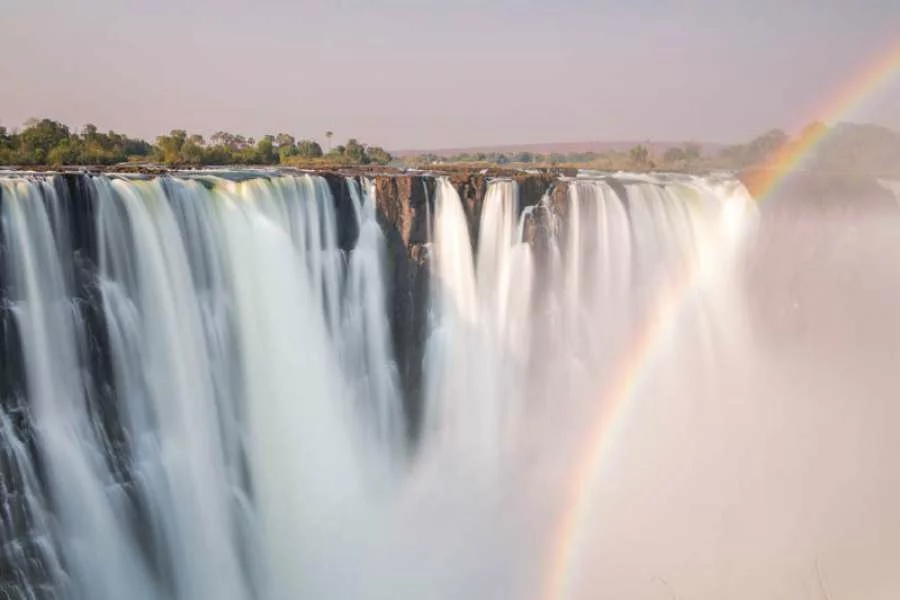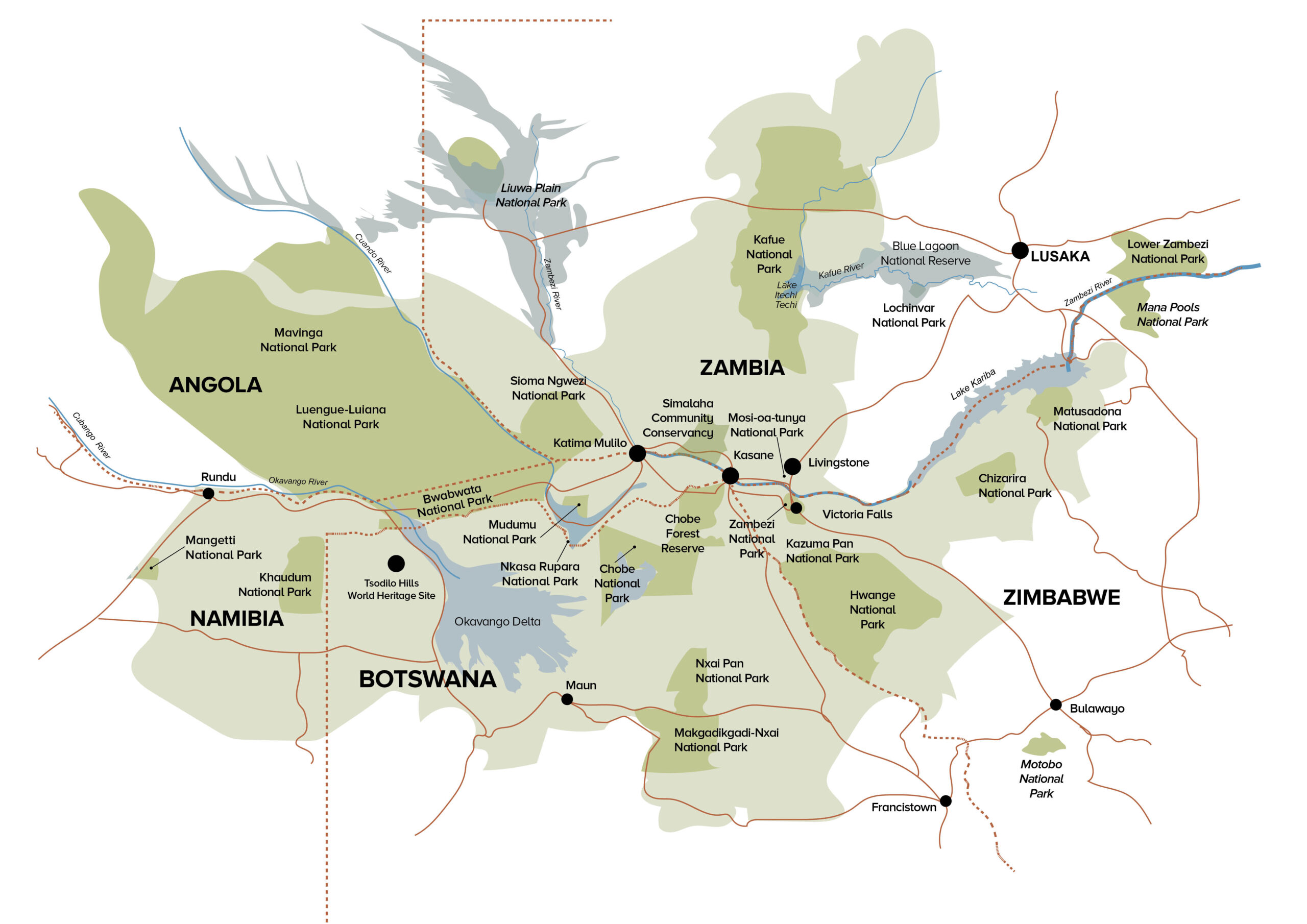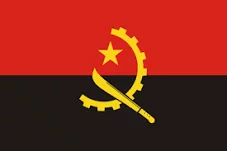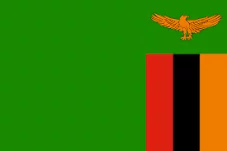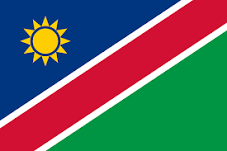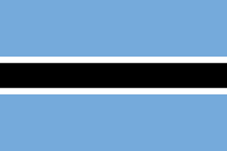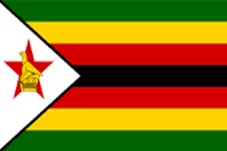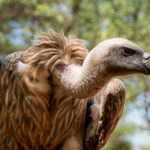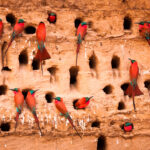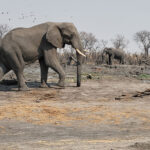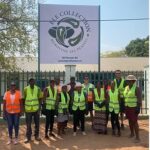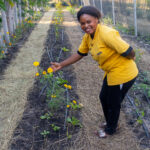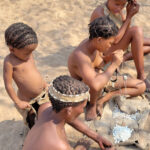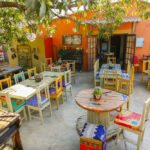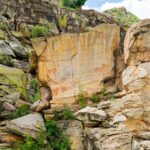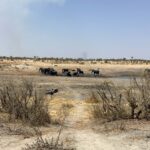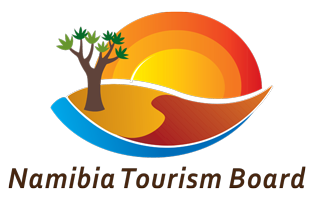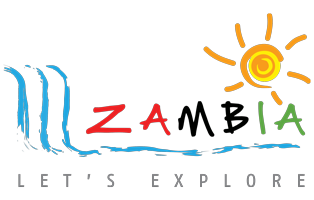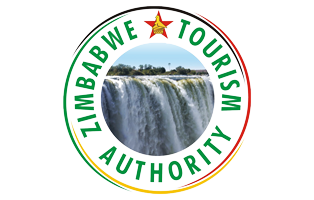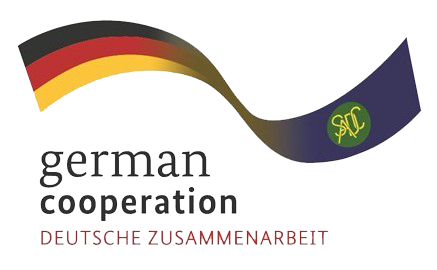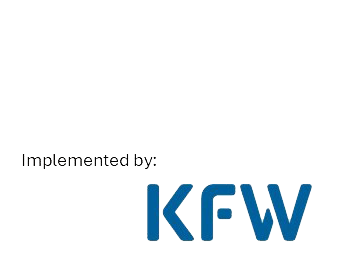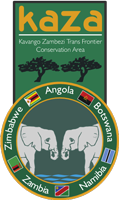Kavango Zambezi
Imagine a vast African landscape, where thousands of elephants tramp ancient migration trails unfettered by national boundaries. Picture vast horizons of forest, swamp, saltpan and savannah that teem with grazing herds and their attendant predators – and mighty rivers that snake across the land towards roaring cataracts, island labyrinths and desert sands. And imagine this region populated by communities who live in harmony with it, knowing that their wellbeing depends upon preserving its natural riches.

Amazing Bird and Wildlife
in its natural habitat.
The Kavango Zambezi boasts a rich in bird and wildlife heritage, with an abundance of iconic African species, such as lions, elephants, zebras, fish eagles, and more.
Immerse yourself in the vibrancy of diverse African Communities.
Unveiling the rich heritage and diverse traditions of African communities, embark on a captivating journey through untold stories, inspiring achievements, and empowering voices.
Rich African Culture & Heritage across the National Parks.
The Kavango Zambezi boasts a rich African heritage, with diverse cultures, traditions, and wildlife, making it a unique destination for travellers.
Unforgettable moments and stunning sights from our National Parks.
The Kavango Zambezi is home to several national parks, including Victoria Falls and Hwange, showcasing breathtaking landscapes and a variety of wildlife.
Trip Planner
Plan your dream trip to Kavango Zambezi in Africa with our one-click Kavango Zambezi trip planner. Explore wildlife, immerse yourself in the culture, and customise your itinerary based on your preferences and budget. Start your unforgettable adventure now.
SEND US AN EMAIL
FREQUENTLY ASKED QUESTIONS
Welcome to the Frequently Asked Questions (FAQs) section of Uncover Kavango Zambezi! Our goal is to help you navigate the enchanting region of Kavango Zambezi, Africa, with ease and confidence. This section offers valuable insights, answering your most pressing questions about travel, accommodations, local customs, and must-see attractions. Let our expert knowledge guide you through the captivating landscapes, vibrant cultures, and unforgettable experiences that await you in Kavango Zambezi. Embark on the journey of a lifetime with the support of Uncover Kavango Zambezi’s FAQs as your ultimate travel companion.
The Kavango Zambezi TFCA is enormous, larger than Germany and Austria combined and nearly twice as large as the United Kingdom.
It lies in the Kavango and Zambezi river basins where Angola, Botswana, Namibia, Zambia and Zimbabwe converge.
The Kavango Zambezi Trans Frontier Conservation Area spans five countries: Angola, Botswana, Namibia, Zambia, and Zimbabwe. The main international gateways depend on where your journey begins, but the most popular entry points are:
-
Livingstone Airport (Zambia) – Ideal for visiting Victoria Falls and the eastern KAZA region.
-
Victoria Falls Airport (Zimbabwe) – A key hub for Victoria Falls and safari lodges in Hwange and beyond.
-
Kasane Airport (Botswana) – Perfect for Chobe National Park and easy access to Namibia and Zambia.
-
Harry Mwanga Nkumbula International Airport (Zambia) – Alternative entry to Victoria Falls from the Zambian side.
-
Hosea Kutako International Airport (Namibia) – Ideal for travelers exploring Namibia’s Caprivi Strip (Zambezi Region).
-
Katima Mulilo Airport (Namibia) – For direct access to the Caprivi/Zambezi Region.
Visa requirements vary depending on your nationality and the countries you plan to visit in the KAZA region. However, two convenient options simplify multi-country travel:
-
KAZA Univisa: Available to citizens of over 65 countries, it allows entry into Zimbabwe and Zambia, and day trips into Botswana (Kazungula border only). It’s valid for 30 days.
-
Individual visas: If not eligible for the KAZA Univisa, you’ll need separate visas for each country:
-
Botswana: Visa-free for many nationalities; check requirements.
-
Namibia: Visas generally required. Check requirements
-
Angola: Visas generally required and must be arranged prior to travel.
-
Zambia: Visa-free for many nationalities; check requirements.
-
Zimbabwe: Visas on arrival for many nationalities; consider the Univisa where available.
-
Always verify visa rules with official embassy websites as regulations may change.
Yes, malaria is present in much of the Kavango Zambezi region, particularly in and around rivers, wetlands, and during the rainy season (Nov–Apr). It’s strongly advised to:
-
Take malaria prophylaxis before, during, and after your trip, as prescribed by a travel health professional.
-
Use insect repellent, sleep under mosquito nets, and wear long sleeves in the evening.
Consult your doctor or a travel clinic 4–6 weeks before departure for tailored advice.
Self-driving in the KAZA region is possible but requires preparation:
-
Namibia and Botswana are popular self-drive destinations with well-marked roads and good infrastructure.
-
4x4 vehicles are strongly recommended, especially in remote areas, national parks, and during the rainy season.
-
Some border crossings (like Kazungula) are well-traveled, but you must carry correct documentation, including vehicle papers and cross-border permits.
-
Fuel stations are sparse in remote areas, so always carry extra fuel and supplies.
Local knowledge, GPS maps, and apps like Tracks4Africa are helpful. If new to the region, consider a guided self-drive tour or travel with an operator.
Both sides offer unique perspectives of the majestic Victoria Falls:
-
Zambian Side (Livingstone):
-
Closer, more intimate view of the falls, especially during high water.
-
Devil’s Pool and Livingstone Island offer thrilling seasonal experiences.
-
In dry season (Oct–Dec), parts of the falls may dry up.
-
-
Zimbabwean Side (Victoria Falls Town):
-
Panoramic views and more comprehensive perspectives.
-
75% of the falls are visible year-round from this side.
-
Easier access to multiple viewpoints via Victoria Falls National Park.
-
For the full experience, many traveler's visit both sides (especially with the Kavango Zambezi Univisa).
Birding is fantastic year-round, but the best time is between November and March, when:
-
Migratory species arrive from Europe and northern Africa.
-
The landscape is green and vibrant, attracting a wider diversity.
-
Wetland and floodplain areas such as Caprivi/Zambezi Region, Okavango Delta, and Chobe River come alive.
Over 600 species of birds can be seen in the region, including sought-after species like Pel’s fishing owl, African skimmers, and carmine bee-eaters.
| Month | Season | Weather & Conditions |
|---|---|---|
| May–August | Dry Winter | Cool mornings (10–15°C), warm sunny days (20–28°C), minimal rain. Excellent for wildlife viewing. |
| September–October | Hot & Dry | Very hot (up to 35–40°C), dry conditions. Great game viewing near water sources. |
| November–March | Wet Season | Rainy and humid, with dramatic thunderstorms. Lush green landscapes, ideal for birding but wildlife viewing can be more challenging. |
| April | Transition | End of rainy season. Landscapes remain green and beautiful, with improving wildlife visibility. |

 Angola
Angola  Botswana
Botswana  Namibia
Namibia  Zambia
Zambia  Zimbabwe
Zimbabwe 